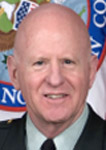Audio Segment One
Implementation of the National Guard’s Joint Force Headquarters-State that enables a governor to coordinate military units in support of first responders. How it is built from the bottom up and serves as an interagency, intergovernmental task force under the incident command system (ICS) and the National Response Plan (NRP) for joint planning and response.
Duration: 6 Minutes 07 Seconds
Audio Segment Two
The use of liaison officers (LNOs) for national security special events in 2004 and how the Guard’s organizational footprint for those events serves as the model for coordination and communications in the future.
Duration: 3 Minutes 16 Seconds
Audio Segment Three
The U.S. Northern Command’s role in defining and coordinating the National Guard and authorities that transcend national, state, and local jurisdictions. Also, the National Guard as a NorthCom provider of state-level situational awareness.
Duration: 3 Minutes 56 Seconds
Audio Segment Four
The linkage between the National Guard’s Joint Intelligence Information Center and NorthCom’s data-fusion operations. Managing the intel interfaces with local law-enforcement agencies and their federal interagency partners.
Duration: 2 Minutes 20 Seconds
Audio Segment Five
Managing the human resources challenge of making the best use of Guardsmen who are also first responders. Also, incident planning and the need to avoid the “double counting” of Guardsmen/responders.
Duration 3 Minutes 43 Seconds
Audio Segment Six
Communications interoperability with first responders. Also, a discussion of ET 3000, the Guard’s on-site package of satellite communications terminals.
Duration 1 Minute 36 Seconds
Audio Segment Seven
National Guard training for first responders – i.e., the Automated Exercise and Assessment System (AEAS), the Guard’s simulation-based training and assessment system, which provides first responders with functional and tabletop exercises such as CBRNE scenarios, command-level exercises, the exercising of ICS and the NRP, and inter-agency communications and jurisdiction procedures and policies. Also, the use of National Guard armories for first-responder training.
Duration 6 Minutes 09 Seconds
Audio Segment Eight
The Guard’s CBRNE Enhanced Response Force Packages (CERFPs) and how they replicate the Marine Corps’ Chemical/Biological Incident Response Force (CBIRF). An update on the Guard’s WMD (weapons of mass destruction) Civil Support Teams (CSTs).
Duration 4 Minutes 46 Seconds
Audio Segment Nine
Priority requirements, including the equipment needed–radios, medical sets, trucks, engineering equipment, etc.–to support the Guard’s domestic mission. Also, an extended discussion on the ACU-1000 and interoperable communications.
Duration 5 Minutes 44 Seconds
Audio Segment Ten
General Blum’s emphasis on the necessity for regional interagency/intergovernmental training and exercises.
Duration 4 Minutes 32 Seconds
Audio Segment Eleven
How interagency/intergovernmental communications and coordination in a regional response scenario reflects a collaborative approach between and among governors.
Duration 3 Minutes 46 Seconds

John F. Morton
John F. Morton is the Strategic Advisor for DomPrep. He is also the Homeland Security Team Lead for the Project on National Security Reform (PNSR). A member of the DomPrep team since its founding, he has served as managing editor for writer assignments and interviewer for scores of DomPrep audio interviews.
- John F. Mortonhttps://www.domesticpreparedness.com/author/john-f-morton
- John F. Mortonhttps://www.domesticpreparedness.com/author/john-f-morton
- John F. Mortonhttps://www.domesticpreparedness.com/author/john-f-morton
- John F. Mortonhttps://www.domesticpreparedness.com/author/john-f-morton

H. Steven Blum
Lieutenant General H. Steven Blum, USA (Ret.), former Deputy Commander, United States Northern Command, was the first National Guard* officer to serve as a Deputy U.S. Combatant Commander. His previous assignment was as Chief of the National Guard Bureau. In that post, he served as the principal adviser to the Secretary and Chief of Staff of the Army, and to the Secretary and Chief of Staff of the Air Force, on all National Guard issues. Prior to commanding the 29th Infantry Division (Light), General Blum served as Assistant Adjutant General for the Army, as Commanding General, Maryland Army National Guard, and as assistant Division Commander (Support), 29th Infantry Division (Light). He also previously served as the Commanding General for the Multinational Division (North) Stabilization Force 10 in Operation Joint Forge, Bosnia Herzegovina.
- H. Steven Blumhttps://www.domesticpreparedness.com/author/h-steven-blum
- H. Steven Blumhttps://www.domesticpreparedness.com/author/h-steven-blum
- H. Steven Blumhttps://www.domesticpreparedness.com/author/h-steven-blum
- H. Steven Blumhttps://www.domesticpreparedness.com/author/h-steven-blum








